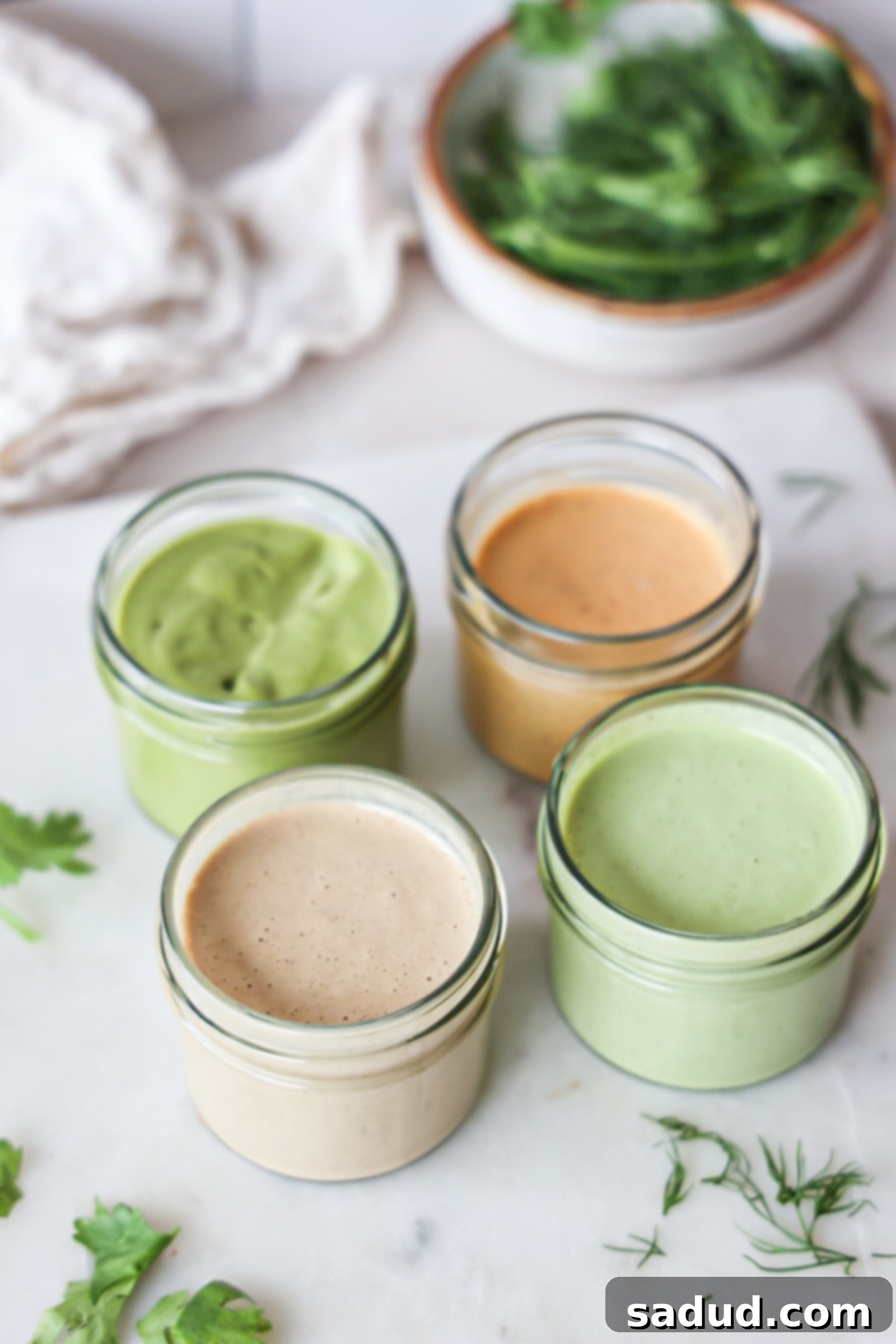Elevate Your Meals: 4 Incredible Homemade Salad Dressings (Vegan, Gluten-Free & Ready in Minutes!)
Unlock a world of fresh flavors with these incredibly easy-to-make, versatile, and healthy homemade salad dressing recipes. Crafted in under 5 minutes, these dressings include creamy sesame peanut dressing, herby tahini sauce, vibrant cilantro lime dressing, and a delightful sweet and spicy tahini. There’s a perfect match for every palate and dish. Best of all, every single recipe is naturally gluten-free, vegan, Whole30, and paleo-friendly, making healthy eating both simple and delicious!
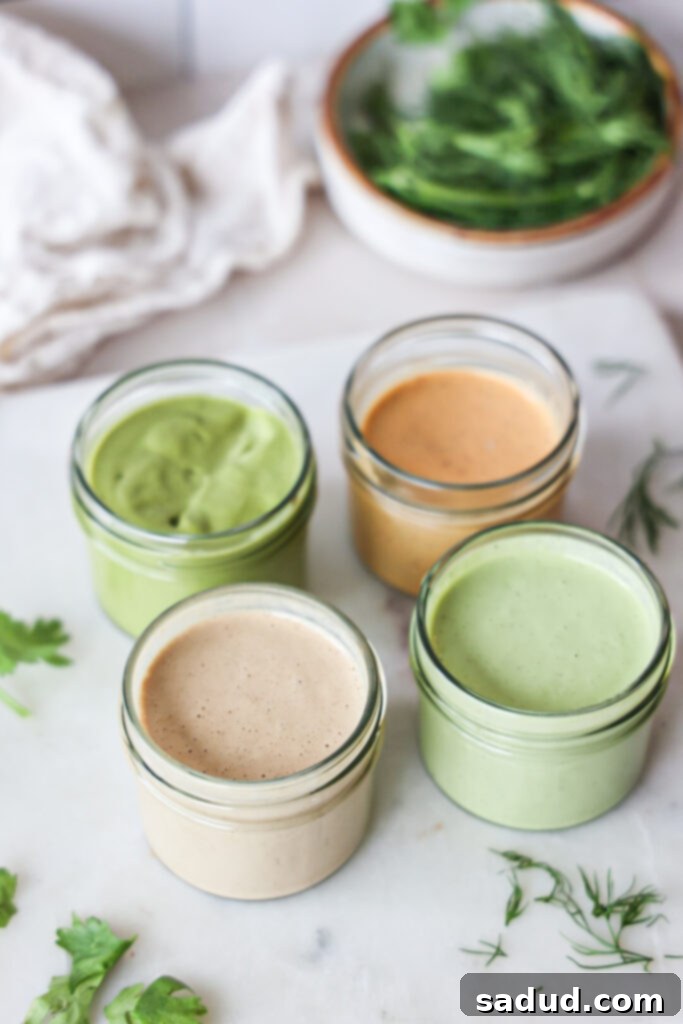
Why Choose Homemade Salad Dressings?
In today’s fast-paced world, convenience often comes at a cost, especially when it comes to food. Store-bought salad dressings, while seemingly quick and easy, are frequently laden with hidden refined sugars, artificial preservatives, unhealthy oils, and other additives that can detract from an otherwise healthy meal. Even brands marketing “healthy” options can be surprisingly expensive, quickly adding up and busting your grocery budget.
Making your own salad dressings at home is not just a healthier alternative; it’s a game-changer for your well-being and your wallet! By taking just a few minutes, you gain complete control over the ingredients, ensuring your dressings are made with wholesome, nutrient-dense components. This allows you to avoid unwanted fillers and tailor flavors precisely to your preferences, creating a truly personalized culinary experience.
One of the best parts about these particular recipes is how accessible the ingredients are. I’ve intentionally focused on using common pantry staples, so you won’t need to hunt down obscure items. You likely already have many of these wholesome ingredients on hand, making these dressings not only cost-effective but also incredibly convenient to whip up anytime inspiration strikes.
Each healthy dressing recipe featured here is thoughtfully crafted to be vegan, gluten-free, dairy-free, and refined sugar-free. They embrace good-for-you, natural ingredients that nourish your body without compromise. Ready to transform your salads into vibrant, flavorful masterpieces? Before you dive into these delicious dressings, make sure your salad base is perfect. Check out my “how to build a salad” post here for some fantastic salad inspiration and formulas!
Watch the Homemade Salad Dressing Recipe Video
How to Make Healthy Salad Dressings Effortlessly
Healthy eating should never feel complicated or time-consuming, and neither should preparing fresh, homemade ingredients. These incredible salad dressings exemplify simplicity: each one can be made from scratch in under 5 minutes, primarily using just a blender!
The process couldn’t be easier: simply gather all your chosen ingredients (excluding water for initial blending), toss them into your blender, and blend until you achieve a wonderfully smooth consistency. Once blended, you can gradually add a tablespoon or two of water, if needed, to thin the dressing to your desired texture. After you’ve reached your ideal consistency, just transfer it to an airtight container, and it’s ready for storage or immediate enjoyment!
Today, we’re putting the spotlight on four of my absolute favorite, versatile, and wholesome salad dressings that you’ll want to keep on rotation:
- Creamy Herby Tahini Dressing: A rich, earthy, and herbaceous dressing perfect for Mediterranean-inspired dishes or simple green salads.
- Cilantro Lime Sauce/Dressing: Bright, zesty, and refreshing, this dressing adds a vibrant kick to Mexican and Southwestern flavors.
- Creamy Sesame Peanut Dressing: A luscious, umami-packed dressing with a hint of sweetness, ideal for Asian-inspired salads, noodles, or wraps.
- Sweet & Spicy Tahini Dressing: A dynamic blend of sweet and fiery notes, offering a delicious twist to roasted vegetables or grain bowls.
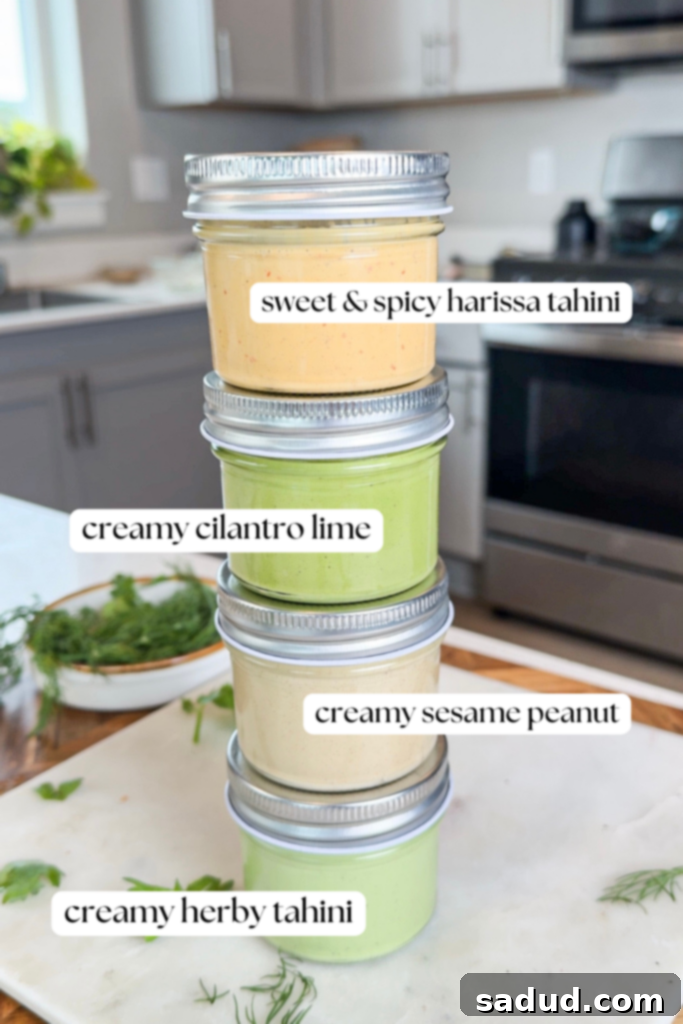
All of these homemade salad dressings are carefully designed to fit various dietary needs and preferences. They are universally Whole30 compliant, vegan (free from all animal products), and paleo-friendly. For those following a ketogenic diet, these recipes can easily be made keto-friendly by simply substituting traditional sweeteners like maple syrup or honey with monk fruit sweetener, ensuring they fit seamlessly into your low-carb lifestyle.
Key Ingredients & Smart Substitutions for Perfect Dressings
Crafting a truly exceptional salad dressing involves balancing key flavor components to create a harmonious and satisfying experience. A good rule of thumb for building a full-bodied dressing is to incorporate elements of fat, acid, salt, and a touch of heat. I also love to add a tiny bit of sweetness to round out the flavors and create that perfect balance. The full list of ingredients and precise measurements for each specific dressing can be found in the detailed recipe card at the very bottom of this post.
- Fat: This forms the creamy base of many dressings, providing a rich mouthfeel and helping to carry flavors. Healthy fats like olive oil and avocado oil are excellent choices, offering not only great taste and texture but also essential brain and hormone-boosting nutrients. For an oil-free or extra creamy alternative, unsweetened, plain Greek yogurt (dairy or dairy-free coconut yogurt) works beautifully, adding a lovely tang and thickness.
- Acid: Acids are crucial for brightening flavors, cutting through richness, and adding a refreshing zing. Think of versatile options like apple cider vinegar, fresh lemon juice, zesty lime juice, or even a splash of orange juice for a sweeter note. These elements awaken the palate and prevent the dressing from feeling flat.
- Salt: A fundamental flavor enhancer, salt is self-explanatory but absolutely essential. It brings out the natural tastes of all the other ingredients and makes them pop.
- Heat: For an exciting depth of flavor and a gentle kick, I highly recommend incorporating a touch of heat. Red pepper flakes, a dash of your favorite hot sauce (like sriracha), or even freshly grated ginger can elevate a dressing from good to extraordinary, adding a subtle warmth that lingers pleasantly.
- Sweetener: A hint of sweetness is often the secret ingredient that balances the tartness of the acid and the spice of the heat. My preferred natural sweeteners include honey (for non-vegan options), maple syrup, or monk fruit for a sugar-free alternative. This subtle touch of sweetness ensures a well-rounded and irresistible dressing.
Let’s dive a bit deeper into some of the main ingredients you’ll find in these homemade salad dressings:
- Fats/Creamy Bases:
- Tahini: A rich, nutty paste made from ground sesame seeds, perfect for creamy, earthy dressings.
- Peanut Butter: Offers a distinct nutty, slightly sweet, and savory flavor, creating incredibly satisfying dressings.
- Olive Oil or Avocado Oil: Essential for their healthy fats, smooth texture, and subtle flavor notes.
- Greek Yogurt or Coconut Yogurt (unsweetened): Provides a tangy, creamy, and often probiotic-rich base, especially great for oil-free versions.
- Seasonings & Spices:
- Celtic Sea Salt: My go-to for its beneficial electrolyte properties and superior flavor.
- Black Pepper: A universal enhancer.
- Red Pepper Flakes: For a customizable level of heat.
- Cumin: Adds a warm, earthy depth, particularly in cilantro-lime dressing.
- Fresh Herbs & Aromatics:
- Cilantro: Bright and herbaceous, excellent for vibrant, fresh dressings.
- Parsley: Fresh and clean, perfect for adding a green, slightly peppery note.
- Garlic: A foundational flavor enhancer that adds aromatic depth to almost any dressing.
- Natural Sweeteners:
- Honey: A natural, unrefined sweetener (use for non-vegan versions).
- Maple Syrup: A vegan-friendly, rich, and natural liquid sweetener.
- Monk Fruit: An excellent zero-calorie, sugar-free option for keto and low-carb diets.
Tips for Making Delicious Oil-Free Dressings
While avocado oil and olive oil are undeniably healthy fats, packed with essential nutrients vital for brain function and hormone health (especially beneficial for women!), there are times when you might prefer an oil-free dressing. I generally highly recommend including these healthy oils not only for their robust health benefits and satiating properties but also for the unparalleled depth of flavor and luxurious texture they impart to a dressing. They contribute significantly to the overall mouthfeel and richness.
However, if you’re aiming for an entirely oil-free version or simply wish to reduce your oil intake, it’s quite simple to achieve. For recipes that call for oil, you can easily substitute it with an equal amount of unsweetened, plain coconut yogurt or Greek yogurt. This substitution is particularly effective for achieving a wonderfully creamy consistency, often making the dressing even thicker and more decadent without the added oil. This technique works well in dressings where the yogurt’s slight tang complements the other flavors, making for a lighter yet equally satisfying option.
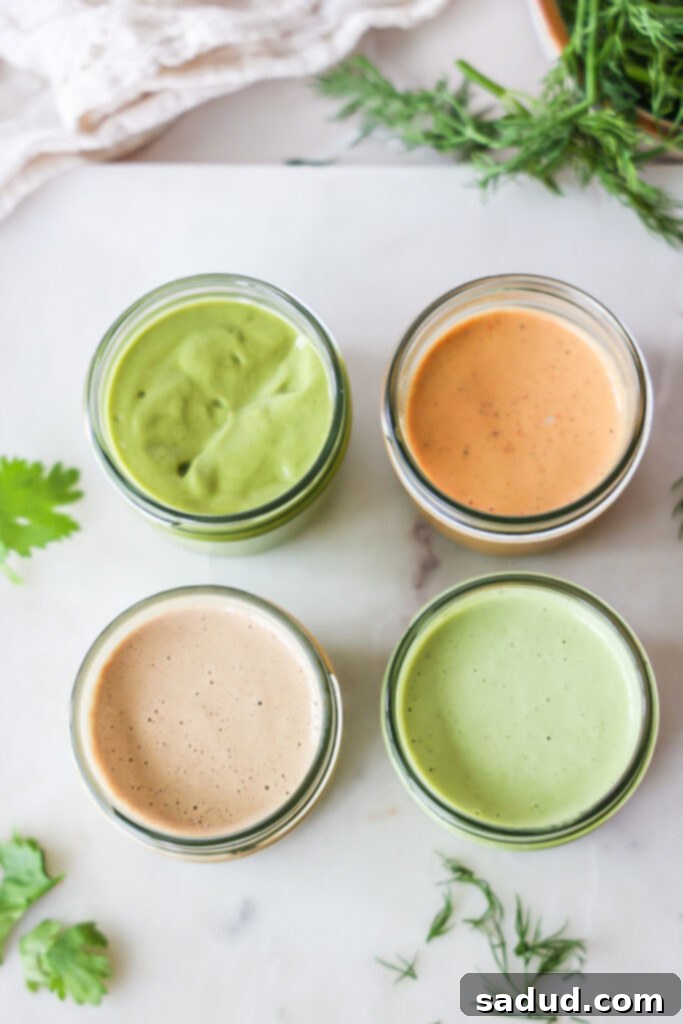
Storing Your Homemade Dressings for Freshness
Proper storage is key to extending the life and freshness of your homemade salad dressings. Always store them in an airtight container in the refrigerator to prevent oxidation and maintain their vibrant flavors. Glass jars with tight-fitting lids, like mason jars, are an excellent choice for this purpose.
For those who love to meal prep or need to take their healthy salads and nourish bowls on the go, these to-go dressing containers are an absolute lifesaver! They’re perfectly sized to carry individual portions without any leaks or spills, ensuring your greens stay crisp until it’s time to dress them.
I personally find that making smaller batches works best for my household (just Thomas and I), so I frequently use and highly recommend these 8oz mason jars. They’re ideal for keeping a fresh supply without excess waste. If you’re planning to double or triple these recipes for a larger family, entertaining a crowd, or simply want to have more on hand, then larger 16oz jars would be the perfect size to accommodate your needs.
Creative Ways to Serve and Enjoy Your Healthy Salad Dressings
These homemade dressings are incredibly versatile and can do so much more than just elevate a simple salad. Get creative in the kitchen and use them to transform various dishes!
- Drizzle over Salads: Of course, their primary purpose! Elevate any green salad, grain salad, or chopped vegetable salad with a generous drizzle.
- Use on Your Favorite Nourish Bowl: These dressings are perfect for tying together all the components of a healthy grain or nourish bowl, from roasted veggies and grains to proteins.
- Pour over Your Favorite Protein: Use them as a flavorful finishing sauce for grilled chicken, baked salmon, pan-seared tofu, or roasted chickpeas.
- Dress Roasted Vegetables: Toss roasted broccoli, carrots, Brussels sprouts, or sweet potatoes with a dressing post-roasting for an extra layer of flavor.
- Thickened as a Dipping Sauce: By simply reducing the amount of water used (or even omitting it entirely), you can create a thicker, more sauce-like consistency. This makes them fantastic for dipping fresh vegetable sticks, crackers, or even chicken tenders.
- Enhance Noodle Dishes: The creamy sesame peanut sauce, in particular, is a phenomenal addition to your favorite cold noodle salads or warm stir-fry dishes.
- Marinades for Meats or Veggies: Many of these dressings, especially the cilantro lime or sweet & spicy tahini, can double as quick and easy marinades for grilling or baking.
- Spread for Sandwiches & Wraps: Add a layer of flavor to your sandwiches, wraps, or even veggie burgers instead of mayonnaise or other processed condiments.
How Long Do Homemade Healthy Salad Dressings Last?
One of the beauties of these fresh, homemade dressings is their respectable shelf life, allowing you to enjoy them for more than just one meal. When stored correctly in an airtight container within the refrigerator, these healthy homemade dressings will typically last a generous 1 1/2 to 2 weeks. This makes them perfect for meal prepping at the beginning of the week!
It’s completely normal for natural dressings to separate a bit over time, especially those made with tahini or nut butters. If you notice any separation, simply give the container a good shake or a quick whisk before serving, and it will emulsify beautifully again. Always trust your senses; if a dressing develops an off smell or unusual appearance, it’s best to discard it.
Complement Your Dressings with These Healthy Salad Recipes
Now that you’re equipped with an arsenal of incredible homemade dressings, it’s time to put them to good use! Each of these healthy and delicious salad recipes would be perfectly complemented by your new favorite dressings, creating a vibrant and satisfying meal.
- Copycat Sweetgreen Crispy Rice Bowl: A popular, textural bowl that would pair wonderfully with the creamy sesame peanut dressing.
- Thai Crunch Salad: The creamy sesame peanut dressing is an obvious choice here, enhancing the classic Thai flavors.
- Roasted Broccoli Caesar Salad: A delightful twist on a classic, which could be dressed with the herby tahini for a fresh take.
- Salmon Nourish Bowl: Any of these dressings would be fantastic, especially the cilantro lime or herby tahini, to complement the richness of salmon.
- Healthy Breakfast Bowl: While unusual, a drizzle of the herby tahini or sweet & spicy tahini could add a savory element to certain breakfast bowls.
- Tahini Caesar Roasted Brussels Sprouts Salad: Naturally calling for a tahini-based dressing, the creamy herby tahini would be a perfect match.
- Vegan Nicoise Salad: A fresh, substantial salad that would be beautifully accented by the herby tahini or cilantro lime dressing.
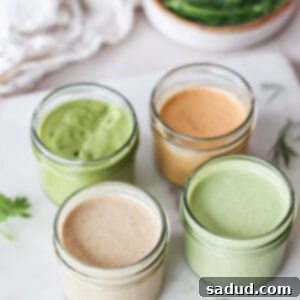
Healthy, Vegan Salad Dressings
Pin Recipe
Ingredients
Creamy Herby Tahini Sauce
- 1/4 cup tahini
- 1/4 cup plain, unsweetened coconut yogurt or greek yogurt
- 1/2 cup herbs (I used cilantro & Parsley)
- 2 small garlic cloves
- 2-3 tbsp lemon juice
- 1-2 tsp maple syrup, honey, or monk fruit
- good pinch of sea salt & pepper
- water, if needed to thin *optional
Cilantro Lime Dressing
- 1 cup cilantro, packed
- 1/4 cup unsweetened plain coconut yogurt/greek yogurt
- 2 tbsp avocado oil or olive oil
- 1 large garlic clove
- 3 tbsp lime juice
- 1 tsp honey, maple syrup, or monk fruit
- 1/4 tsp cumin
- 1/2 tsp sea salt *to taste
- red pepper flakes *optional
Sweet & Spicy Harissa Tahini Dressing
- 1/4 cup tahini
- 2 tbsp lemon juice
- 1 tsp coconut aminos or tamari (soy sauce)
- 2 tbsp olive oil or avocado oil *can sub unsweetened, plain coconut yogurt or greek yogurt
- 1 tbsp sriracha or similar hot sauce
- 1-2 tsp honey
- 1 small garlic clove
- 1/2-3/4 tsp harissa paste
- 1/4 tsp sea salt
- 2 tbsp water, as needed
Creamy Sesame Peanut Dressing
- 1/4 cup peanut butter
- 2 tsp sesame oil
- 1 tbsp apple cider vinegar
- 1 tbsp coconut aminos or tamari
- 2 tsp maple syrup or monk fruit
- 1/2 tsp ground ginger
- 1 garlic clove
- red pepper flakes or 1/2 tbsp sriracha *optional
- pinch of sea salt
- water, as needed to thin
Instructions
-
For each dressing, begin by adding all of the specified ingredients (except any optional water) into your blender. Blend the mixture until it becomes as smooth and creamy as possible. Once you’ve achieved a uniform consistency, gradually add water, one tablespoon at a time, blending briefly after each addition, until the dressing is thinned out to your desired consistency.
-
After the initial blending and thinning, take a moment to taste the dressing and adjust the flavors to your personal liking – remember, this is YOUR dressing! Do you think it could use a little more heat for an extra kick, or perhaps a touch more sweetness to balance the tang? Add a pinch extra of your preferred ingredient. Craving more salt to enhance the overall taste? Sprinkle it in. Don’t hesitate to play around with the seasonings until the dressing truly satisfies your unique taste buds!
Video
Notes
- Storing dressings: Store your freshly made dressings in an air-tight container in the fridge. For convenient meal prep or when you’re taking a salad or bowl on the road, these highly-rated to-go dressing containers are simply amazing and prevent spills! For smaller batches, perfect for 1-2 people like Thomas and I, I find these 8oz mason jars to be ideal. If you’re doubling the recipes for a larger crowd or a family-sized portion, 16oz jars would be your best bet to ensure you have enough.
- How long do Homemade Healthy salad dressings last: When properly stored in an air-tight container and refrigerated, these homemade dressings will maintain their freshness and flavor for a good 1 1/2 to 2 weeks! If you notice that they start to separate or appear a bit settled, don’t worry—this is natural. Just give them a good shake or a quick whisk, and they’ll be perfectly emulsified and ready to enjoy again!
